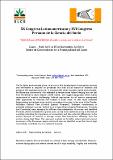Por favor, use este identificador para citar o enlazar a este item:
http://hdl.handle.net/10261/115172COMPARTIR / EXPORTAR:
 SHARE
BASE SHARE
BASE
|
|
| Visualizar otros formatos: MARC | Dublin Core | RDF | ORE | MODS | METS | DIDL | DATACITE | |

| Título: | Fingerprinting sediment contribution from alpine soils to mountain reservoirs |
Autor: | Palazón Tabuenca, Leticia CSIC ORCID ; Gaspar Ferrer, Leticia CSIC ORCID ; Latorre Garcés, Borja CSIC ORCID ; Navas Izquierdo, Ana CSIC ORCID | Palabras clave: | Alpine soils fingerprinting procedure Erosion |
Fecha de publicación: | nov-2014 | Citación: | XX Congreso Latinoamericano de la Ciencia del Suelo: “Educar para preservar el suelo y conservar la vida en la Tierra” (Cusco, Perú. 9-15 noviembre 2014) XVI Congreso Peruano de la Ciencia del Suelo: “Educar para preservar el suelo y conservar la vida en la Tierra” (Cusco, Perú. 9-15 noviembre 2014) |
Resumen: | Soil in alpine environments plays a key role in the development of ecosystem services and information is required on processes that lead to soil erosion to maintain and preserve this important resource. In common with other mountain alpine environments, the Benasque catchment is characterized by temperatures below freezing that can last from November to April, intense rainfall events, and rugged topography which makes assessment of erosion challenging. Indirect approaches to soil erosion assessment offer opportunity to evaluate soil erosion in such areas. In this study sediment fingerprinting procedures were used to evaluate soil sources in the area of the Posets- Maladeta National Park (Central Spanish Pyrenees). Sediment contributions of potential sediment sources defined by soil type (Kastanozems/Phaeozems; Fluvisols and Cambisols) were assessed by different characterizations of sources and identified Fluvisols, which dominate the riparian zone, as the main sediment source at the time of sampling indicating the importance of connectivity and also potential differences in the source dynamic of material in storage versus that transported efficiently from the system during high flows. The approach enabled us to better understand soil erosion processes in the Benasque alpine catchment wherein identified areas that, due to high connectivity, contribute more to sediment deposits. | Descripción: | 6 Pags.- 1 Tabl.- 1 Fig. | URI: | http://hdl.handle.net/10261/115172 |
| Aparece en las colecciones: | (EEAD) Comunicaciones congresos |
Ficheros en este ítem:
| Fichero | Descripción | Tamaño | Formato | |
|---|---|---|---|---|
| NavasA_XXCongLatCienSuel_2014.pdf | 312,96 kB | Adobe PDF |  Visualizar/Abrir |
CORE Recommender
Page view(s)
251
checked on 19-abr-2024
Download(s)
130
checked on 19-abr-2024
Google ScholarTM
Check
NOTA: Los ítems de Digital.CSIC están protegidos por copyright, con todos los derechos reservados, a menos que se indique lo contrario.
